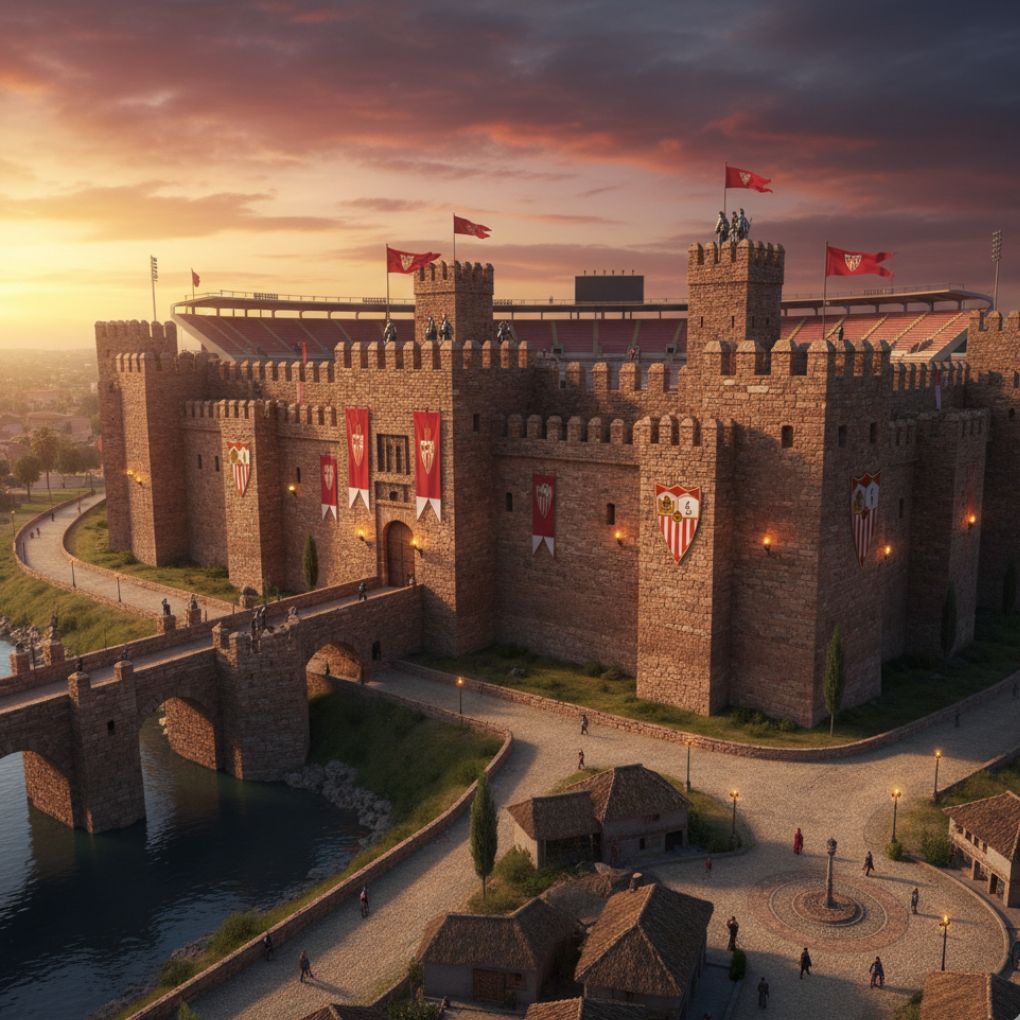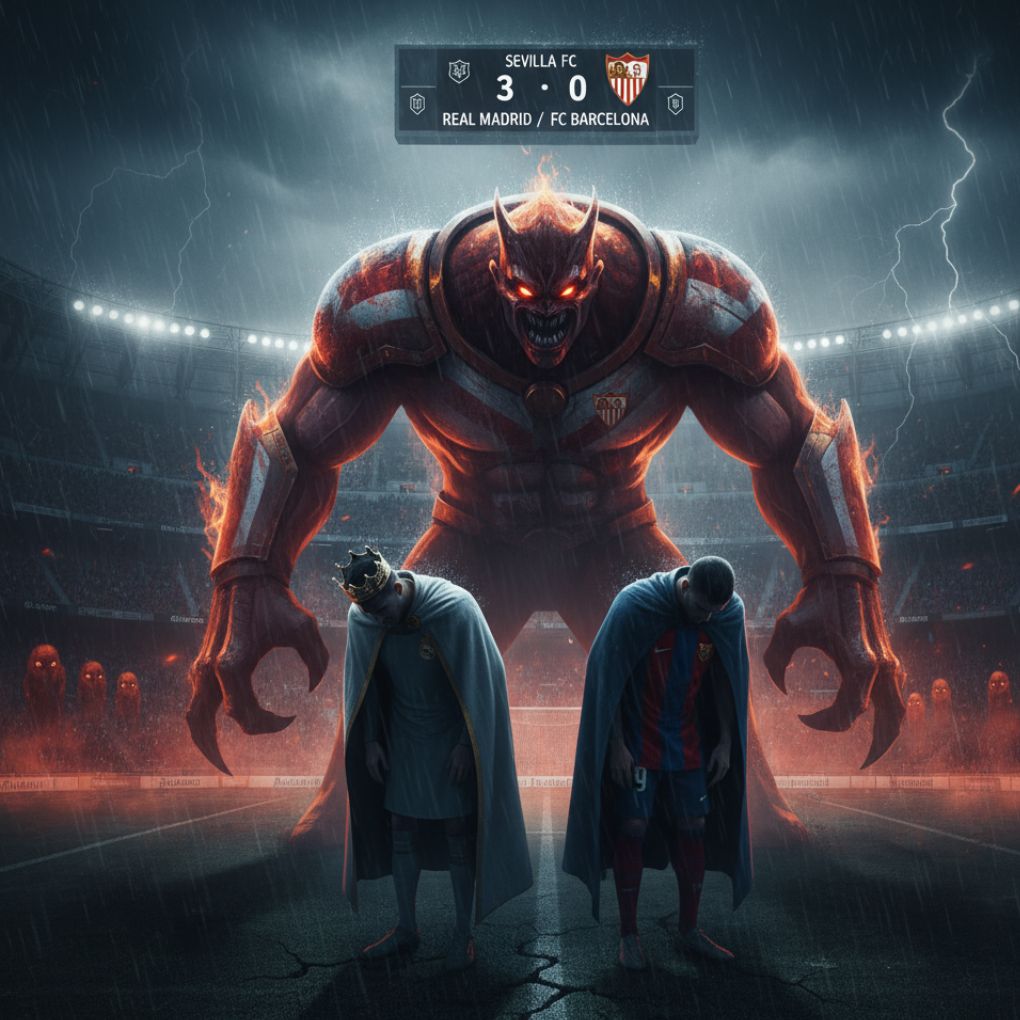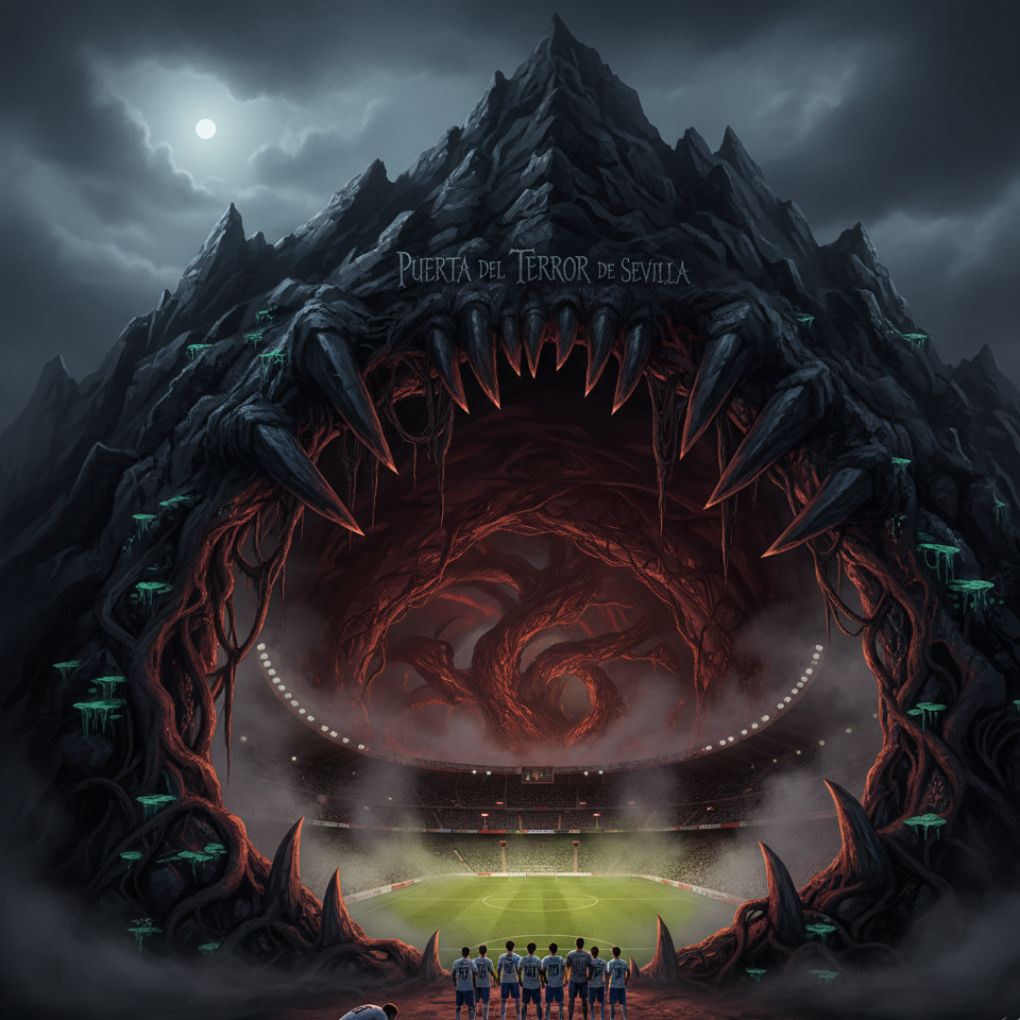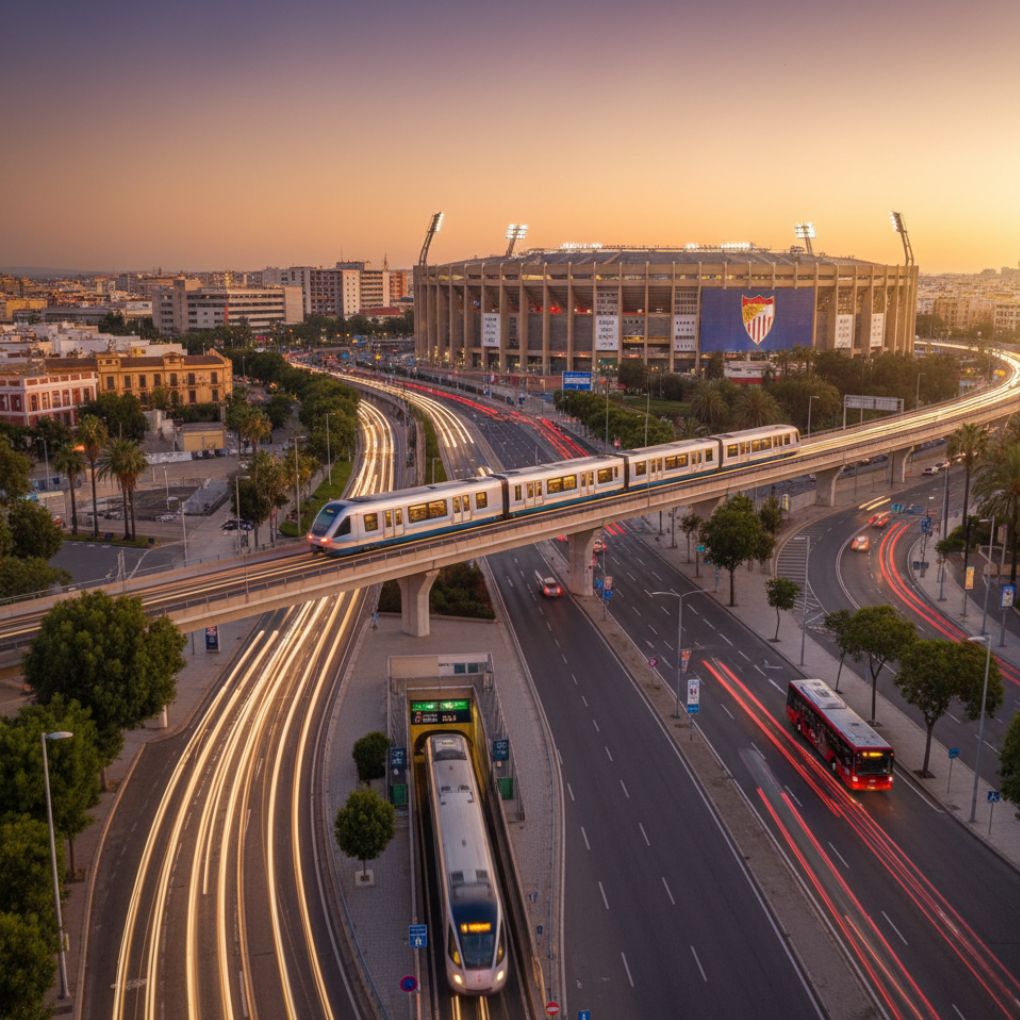
18 November 2025
Ramon Sanchez Pizjuan's exterior is illuminated in Sevilla FC’s red colours on a match night. The 2015 addition of a new LED-clad façade created a striking visual effect that warms up the atmosphere before big games.
In Spanish football, few venues are as notorious for their intimidating atmosphere as Sevilla FC’s home ground, the Estadio Ramón Sánchez-Pizjuán. Located in the Nervión district of Seville and seating around 43,000 fans, this stadium has earned a reputation as one of La Liga’s toughest stadiums for visiting teams.
Opponents stepping into the Sánchez-Pizjuán face a perfect storm of passionate support, claustrophobic design, and proud club tradition, a combination that often makes the difference on the pitch. Even Real Madrid’s players and coaches acknowledge that they have “historically found life tough” at the Sánchez-Pizjuán, where the crowd is always lively and hostile to visitors. In short, this stadium is widely regarded as a true fortress in Spanish football.

One reason the Sánchez-Pizjuán is so formidable is the strong home record Sevilla FC has established there over the decades. Since its inauguration in 1958, Sevilla has amassed 596 top-flight home victories at the Sánchez-Pizjuán, the fifth-most of any club at a single stadium in La Liga history.
Only the likes of Real Madrid (Santiago Bernabéu), Valencia (Mestalla), Barcelona (Camp Nou), and Athletic Club(San Mamés), all clubs with longer histories or larger stadiums, have won more home games. This highlights how consistently difficult it is for away teams to take points in Nervión.
The stadium’s fearsome reputation isn’t just limited to club football, it even extends to the international stage. The Spanish national team has never lost a match at the Ramón Sánchez-Pizjuán, making it something of a lucky charm (or talismán) for Spain.
Over 22 games played there through 2015, Spain won 19 and drew 3, including famous thrashings like the 12-1 victory over Malta in 1983 that secured Euro 1984 qualification, a night when the Seville crowd truly acted as Spain’s “12th man.”
In fact, during the 1980s, the Andalusian fans earned a reputation for being so raucous and supportive that Sevilla’s stadium became an official home venue for the national team, contributing to those invincible results. Such history underlines the psychological advantage Sevilla enjoys at home, visiting teams know that both club and country rarely falter on this pitch.
Sevilla FC’s own modern history is full of home dominance as well. For instance, in one recent period, the club went 34 consecutive home matches unbeaten (over 415 days spanning more than an entire La Liga season), underscoring how hard it is to beat them at the Sánchez-Pizjuán.
All these records cement the stadium’s status as a fortín (fortress) where a positive result for the away side is a prized rarity. When Sevilla’s players walk out in front of their home fans, they carry not only the confidence of past triumphs but also the expectation that the Ramón Sánchez-Pizjuán will give them an extra edge in battle.

Perhaps the single biggest factor behind the Sánchez-Pizjuán’s toughness is the passion of the Sevilla supporters who pack its stands. The stadium is famed for its intense and passionate crowd, and is “often cited as one of the most intimidating venues for visiting teams” in Spain. From the moment you arrive, you can hear the Sevillistas (nicknamed “Los Palanganas”) singing in unison and chanting at full volume.
Home games begin with a spine-tingling tradition: the entire stadium joins to sing the club’s Himno del Centenario (Centenary Anthem) a capella, an emotionally charged song written by local artist El Arrebato and now belted out “by the fans before each home match”. This ritual sets the tone, turning up the emotional intensity even before kickoff.
Many visiting players have admitted that hearing tens of thousands of Sevillistas singing in harmony, scarves raised aloft, gives them goosebumps and makes the Sánchez-Pizjuán feel like a cauldron.
Inside the ground, organised supporter groups behind each goal lead the noise. In the North Stand (Gol Norte), the ultras group known as Biris Norte creates a nonstop drumbeat of support, while an equally fervent supporters’ section occupies the South Stand (Gol Sur).
These fans coordinate chants, wave huge flags, and sometimes orchestrate mosaic displays covering entire stands during special matches. For example, on big European nights, they might distribute colored placards or wear a single colour as they did by dressing the whole stadium in white before a Europa League quarter-final to create a united visual wall.
The effect is striking from the pitch, opposing players see “a wall of fans all dressed in the same colour, ready to sing with one voice”, and there is literally no quiet corner to escape the pressure.
The fans’ relentless chanting and clapping don’t let up for the full 90 minutes, regardless of the scoreline. It’s not uncommon to hear that the noise levels at Sánchez-Pizjuán are among the loudest in La Liga, especially during derby matches or European fixtures.
All of this makes the atmosphere at Sevilla’s stadium truly intimidating. Long-time Spanish football observers often compare the vibe to that of South American football cathedrals, where the passion in the stands verges on frenzy.
In fact, after a particularly electrifying 3-0 win over Manchester United in 2023, commentators described the Ramón Sánchez-Pizjuán as the most South American among European stadiums, noting that it created the optical illusion of a stadium ready to collapse onto the pitch after every goal.
The stadium’s crowd moves and celebrates in unison so fervently that one is reminded of Boca Juniors’ La Bombonera in Argentina, so much so that one of Sánchez-Pizjuán’s nicknames is “La Bombonera de Nervión,” the Bombonera of Nervión.
That moniker perfectly captures the essence of Sevilla’s home: a place where the supporters can practically shake the ground with their jumping and singing, becoming a true 12th man that unnerves the opposition.
Even visiting teams’ coaches acknowledge the effect of this atmosphere. Before a recent match, Real Madrid’s coach Carlo Ancelotti warned his players that Sevilla away would be a very demanding, tough match, implicitly recognising the role the fired-up Sánchez-Pizjuán crowd plays in making it so difficult.
It’s clear that when you play at the Sánchez-Pizjuán, you’re not just facing eleven men in red and white, you’re facing an entire stadium united against you.
Inside the Ramón Sánchez-Pizjuán on a match night. The steep, towering stands, split into two tiers, put 40,000+ raucous fans right on top of the action, creating a wall of noise that engulfs the pitch.

The physical architecture of the Sánchez-Pizjuán amplifies its intimidating atmosphere. The stadium’s design is essentially a steep-sided bowl with stands that loom close to the pitch on all sides, leaving minimal separation between players and spectators.
When the venue opened in 1958 (designed by architect Manuel Muñoz Monasterio, who also co-designed the Bernabéu), it already had a reputation for excellent sightlines and an imposing shape. Over the years, expansions and renovations, such as the addition of upper decks behind each goal by 1975, maintained this compact, vertical feel.
The result is that today the Sánchez-Pizjuán’s seating rises high and tight around the field, overhanging the touchline to a degree few modern arenas match. Opposing players often describe the sensation of playing there as being surrounded by a wall of people. When you take a corner kick or throw-in, the front rows of Sevilla fans are practically within touching distance, screaming and whistling right at you.
This proximity, combined with the bowl-like configuration, helps trap and concentrate the noise. With 43,000 voices echoing under the Andalusian night sky, the roar can be deafening. There is actually only one small roof (over the main West stand), but the stadium’s concrete structure and continuous seating tiers create an acoustic enclosure that reflects sound.
The chanting of the crowd doesn’t escape, it bounces around and reverberates onto the pitch, adding to the pressure visiting teams feel. As a travel guide for fans notes, the Sánchez-Pizjuán “retains its historic atmosphere” even after modern upgrades. In other words, renovations have improved amenities and aesthetics without dulling the cauldron-like acoustics that make the venue notorious.
Several architectural elements add to the intimidation factor as well. The players’ tunnel empties out right at midfield, meaning from the moment the opponents emerge, they are met with a 360-degree panorama of hostile red-and-white stands.
The stadium’s facade and interior are adorned with symbols of Sevilla’s proud history – from giant murals of club legends at the gates to the enormous mosaic by artist Santiago del Campo on the West exterior wall.
That mosaic, unveiled in 1982 ahead of the World Cup, depicts the Sevilla FC crest and the badges of dozens of famous clubs that have played there, along with key dates in club history.
By the time visiting players step onto the grass, they have walked past monuments to Sevilla’s legacy and into an arena literally designed to swallow them in noise and colour. The psychological impact of such an environment, half art gallery, half lion’s den, cannot be overstated.
]

The Sánchez-Pizjuán’s legend has been cemented by the memorable nights and big-game atmospheres it has produced. European teams in particular have learned how daunting it is to play a high-stakes match at Sevilla.
The Europa League has practically become Sevilla’s playground (with a record 7 titles won), and many of those triumphs were built on big home victories under the lights. For example, in April 2023, Sevilla hosted English Premier League side Manchester United in a Europa League quarter-final second leg after a 2-2 first leg. The home fans created an extraordinary scene, an all-white tifo engulfed the stands, and the team responded by routing United 3-0.
After the match, pundits agreed that the seething atmosphere inside the Sánchez-Pizjuán played a major role in Sevilla’s dominance; United’s players looked shell-shocked by the noise and intensity. It was on nights like that one that the stadium earned comparisons to La Bombonera, as mentioned earlier, because of the visceral energy in the crowd celebrations.
Domestic clashes have been just as electric. Seville derbies (Sevilla FC vs. Real Betis) at the Sánchez-Pizjuán are famously wild affairs, with the stadium sold out and split red-and-green in the stands. The noise in those games is said to be “crazy, crazy” even when watching on TV, and it “gets crazy even before kickoff”, as one observer noted.
Sevilla’s home crowd also relishes matches against the big three: Real Madrid, Barcelona, and Atletico Madrid. In many seasons, Sevilla have managed to upset those giants at home thanks to the crowd lifting the team. It’s common to see Sevilla’s players feed off the fans’ energy, making extra runs, flying into tackles, while the away side struggles to communicate amid the cacophony.
All of this contributes to an almost mythical aura around the Sánchez-Pizjuán. Opponents know that here, Sevilla are never “out” of a match, the fans won’t let them quit, and the momentum can shift in an instant after a big roar or a stirring chorus of the anthem.
The stadium has also been the site of historic matches that live in football folklore, further enhancing its aura. In the 1982 World Cup, the Sánchez-Pizjuán hosted the dramatic semi-final between West Germany and France, which ended 3-3 and went to the first penalty shootout in World Cup history.
The thriller under the Seville night showed the stadium at its best: neutral fans witnessed an unforgettable contest, and the noise levels kept rising through extra time and penalties. Similarly, the 1986 European Cup final took place here, where Steaua Bucharest stunned Barcelona on penalties.
In 2022, Sevilla’s home ground hosted the UEFA Europa League final (Eintracht Frankfurt vs Rangers), with tens of thousands of travelling fans turning it into a carnival, yet many remarked that even that spectacle paled in comparison to a big Sevilla home game for atmosphere.
And as noted earlier, the Spanish national team’s iconic 12-1 victory over Malta in 1983, arguably Spain’s most famous home win, happened at the Estadio Benito Villamarín amid an atmosphere of total devotion and noise.
These chapters of history have woven themselves into the fabric of the stadium. When you enter the ground, you can almost feel the echoes of past celebrations and the weight of games won against the odds.

Aim to arrive in the area 60-90 minutes before kickoff; it helps with security queues and gives time for the anthem. If you plan to eat, do it around Nervión Plaza or the bars along Luis de Morales and streets toward the centre, the choice is better there than right at the gates.
All these reasons make the Ramón Sánchez-Pizjuán a true fortress and one of the most challenging grounds in La Liga, if not all of Europe. As the club proudly says, “the Ramón Sánchez-Pizjuán is not your average stadium”, it’s where beauty meets passion, and together they become that extra player pushing Sevilla to glory.
You can now book 100% genuine and guaranteed tickets to watch Sevilla’s matches via the 1BoxOffice website.